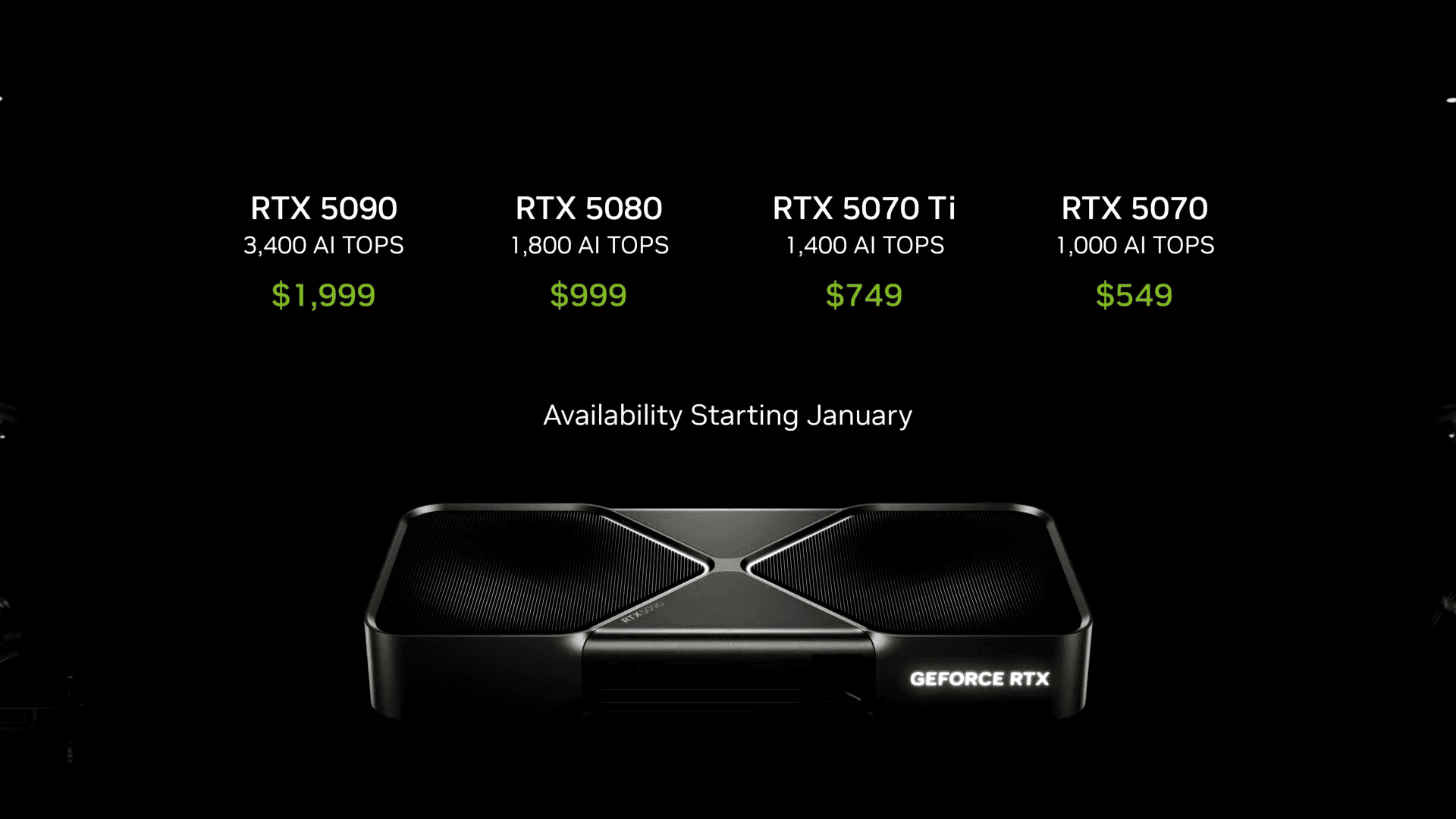Nvidia’s RTX 50 series graphics cards were formally announced by CEO Jensen Huang on January 6th, 2025 and outside of the RTX 5090 model, most people were surprised with their pricing strategy. While the flagship RTX 5090 comes with a hefty price tag of $1,999 (near the top of the expectations), the rest of the lineup offers more competitive pricing than anticipated. The RTX 5080, priced at $999, was estimated to fall within a range of $999 – $1499 but instead costs $200 less than its predecessor at launch.
The RTX 5070 Ti and RTX 5070, priced at $749 and $549 respectively, are both $50 cheaper than their RTX 4000-series counterparts and well below where estimates had those at as well. While the actual availability of the cards at those prices could be uncertain due to factors like scalpers, high demand, and stock shortages, Nvidia’s pricing strategy suggests that it aims to make its latest technology more accessible to a broader audience.
The competitive pricing of the RTX 50 series, particularly excluding the top-tier model, might indicate Nvidia’s response to market pressures from rivals like AMD and Intel. This could potentially disrupt the GPU market, prompting competitors to rethink their pricing strategies and ultimately giving consumers better value in the high-performance graphics card segment.
Nvidia RTX 50-Series Pricing Breakdown

RTX 5090: The Flagship at $1,999
Nvidia’s top-of-the-line offering, the RTX 5090, comes with a hefty price tag of $1,999. This positions it firmly in the enthusiast category, catering to users who demand the absolute best performance and are willing to pay a premium for it.
Release Date: January 30, 2025
RTX 5080: High-End Performance at $999
The RTX 5080 offers a more accessible entry point into high-end gaming at $999. This price point is likely to make it a popular choice for gamers seeking excellent performance without the extreme cost of the 5090.
Release Date: January 30, 2025
RTX 5070 Ti: Stepping Up to $749
The RTX 5070 Ti sits comfortably in the upper mid-range at $749. It offers a compelling option for gamers who want a significant performance upgrade over the base 5070 without a dramatic price increase.
Release Date: February 2025
RTX 5070: Mainstream Performance at $549
The RTX 5070 is the most affordable card in the initial lineup, priced at $549. This makes it a great choice for mainstream gamers who want a solid card that can handle modern games at high settings without breaking the bank.
Release Date: February 2025
| Card | Price |
|---|---|
| RTX 5090 | $1,999 |
| RTX 5080 | $999 |
| RTX 5070 Ti | $749 |
| RTX 5070 | $549 |
Performance Expectations and Comparisons
While official benchmarks are not yet available, leaks and rumors suggest significant performance gains with the RTX 50 series. The 5090 is rumored to be up to 2x faster than the 4090 in certain scenarios. The 5080 is also expected to deliver a considerable performance boost over its predecessor, the 4080.
It’s important to wait for independent benchmarks to get a clear picture of the performance differences between the cards and how they stack up against the previous generation. However, early indications suggest that the RTX 50 series will offer a compelling upgrade for gamers looking for the best possible performance.
Factors to Consider When Choosing a Card
When deciding which RTX 50 series card is right for you, consider your budget, desired resolution and refresh rate, and the types of games you play.
- Budget: The most obvious factor is how much you’re willing to spend.
- Resolution and Refresh Rate: If you’re aiming for 4K gaming at high refresh rates, the 5090 or 5080 will be necessary. For 1440p gaming, the 5070 Ti or 5070 will likely suffice.
- Types of Games: Demanding AAA titles will benefit from the higher-end cards, while less intensive games may run smoothly on the lower-tier options.
Availability and Release Dates
Nvidia has not yet announced specific release dates for the RTX 50 series. However, rumors suggest that the 5090 and 5080 may launch in October, followed by the 5070 Ti and 5070 in November.
It’s advisable to keep an eye on Nvidia’s official announcements and retailer websites for the latest information on availability and release dates.
The Impact of the RTX 50 Series on the GPU Market
The release of the RTX 50 series is expected to have a significant impact on the GPU market. The competitive pricing, especially for the 5080 and below, could put pressure on AMD to respond with price adjustments or new product releases.
Additionally, the increased performance offered by the 50 series may lead to a decrease in demand for previous generation cards, potentially resulting in lower prices for those looking for a more budget-friendly option.
Looking Ahead: Future Developments and Potential Price Adjustments
As with any new technology release, it’s possible that we may see price adjustments or new models added to the RTX 50 series lineup in the future. Nvidia may introduce lower-priced variants of the existing cards or release even more powerful options to cater to the ultra-enthusiast market.
It’s also worth noting that the ongoing global chip shortage could impact the availability and pricing of the RTX 50 series. While Nvidia is likely taking steps to mitigate these challenges, it’s possible that supply constraints could lead to higher prices or longer wait times for certain models.
Key Takeaways
- Nvidia’s RTX 50 series, except for the 5090, features lower prices than expected
- The RTX 5080 is priced $200 less than its predecessor at launch
- Competitive pricing may impact the broader GPU market and benefit consumers
Overview of Nvidia’s RTX 50-Series GPU Launch
Nvidia has just revealed the pricing for their highly anticipated RTX 50 series graphics cards, and it’s causing a stir in the gaming community. The RTX 5090, 5080, 5070 Ti, and 5070 will be priced at $1,999, $999, $749, and $549, respectively.
Many are surprised by the competitive pricing, especially considering the rumored performance leaps with the new Blackwell architecture. This aggressive pricing strategy could shake up the GPU market and put pressure on competitors like AMD. Gamers are eagerly awaiting benchmarks and release dates to see how these new cards perform and how they will impact the overall gaming landscape.
Nvidia’s RTX 50-Series launch at CES 2025 brought significant advancements in graphics technology. The new lineup features improved performance, increased memory, and competitive pricing strategies.
Anticipation Building up to CES 2025
Rumors swirled for months before CES 2025. Tech enthusiasts eagerly awaited Nvidia’s next-gen GPUs. Leaks hinted at major performance gains and new features. The RTX 50-Series was expected to use Nvidia’s Blackwell architecture, succeeding Ada Lovelace.
Speculation focused on the flagship RTX 5090. Many wondered if it would match the leap seen from the 30-Series to 40-Series. Nvidia kept details tightly under wraps, fueling excitement.
Nvidia’s Strategic Pricing Decisions
Nvidia surprised many with its pricing strategy for the RTX 50-Series. The top-end RTX 5090 was priced at $1,999, in line with its predecessor. Lower-tier models saw more aggressive pricing:
- RTX 5080: $999
- RTX 5070: $699
- RTX 5060: $449
This pricing aimed to compete with AMD and Intel in the graphics card market. It also addressed criticisms of high prices in previous generations.
Comparative Analysis With Previous Generations
The RTX 50-Series showed significant improvements over the 40-Series:
| Feature | RTX 5090 | RTX 4090 | Improvement |
|---|---|---|---|
| CUDA Cores | 18,432 | 16,384 | +12.5% |
| Memory | 32GB GDDR7 | 24GB GDDR6X | +33% |
| Memory Bandwidth | 1.5 TB/s | 1 TB/s | +50% |
The new GDDR7 memory provided a notable boost in bandwidth. Ray tracing performance increased by 40% thanks to improved RT cores. AI capabilities also saw a 50% uplift with enhanced Tensor cores.
These gains positioned the RTX 50-Series as a significant upgrade for gamers and creators alike. The improved price-to-performance ratio made high-end GPUs more accessible to a broader range of users.
Frequently Asked Questions
The RTX 50 series has generated significant interest among consumers and enthusiasts. Pricing, release dates, performance improvements, and new features are key topics of discussion.
What are the expected price points for the various models in the RTX 50 series lineup?
The RTX 5090 is rumored to be priced between $1,700 and $1,800. Lower-end models like the RTX 5050 and 5060 may start around $400-$500. Mid-range cards are expected to fall between these price points.
Pricing for most models appears lower than initially anticipated. This trend suggests NVIDIA may be aiming for more competitive pricing across the lineup.
When can consumers anticipate the official release of the RTX 50 series?
NVIDIA has not announced an official release date for the RTX 50 series. Industry speculation suggests a launch in late 2025 or early 2026.
The company typically releases new GPU generations every 1-2 years. This timeline aligns with their previous release schedules.
How does the performance of the RTX 5090 compare to its predecessor, the RTX 4090?
Specific performance figures for the RTX 5090 are not yet available. However, rumors indicate significant improvements over the RTX 4090.
Experts predict substantial gains in ray tracing performance and overall gaming framerates. The RTX 5090 is expected to push 4K and 8K gaming capabilities even further.
Will the RTX 50 series GPUs offer significant improvements in gaming and professional applications?
The RTX 50 series is likely to bring notable advancements in both gaming and professional workloads. Enhanced ray tracing cores and improved DLSS technology are expected to boost gaming performance.
For professional applications, faster tensor cores may accelerate AI and machine learning tasks. Improved video encoding capabilities could benefit content creators and streamers.
What features will differentiate the RTX 50 series from the previous generation graphics cards?
The RTX 50 series is expected to introduce several new features. These may include:
- More efficient architecture on a smaller process node
- Improved ray tracing cores for better real-time lighting
- Enhanced DLSS technology for higher quality upscaling
- Faster memory speeds and increased VRAM capacity
- Better power efficiency and thermal management
How does the RTX 5090’s cost compare to other high-end GPUs currently on the market?
The rumored $1,700 to $1,800 price tag for the RTX 5090 positions it as a premium product. This price range is higher than most current high-end GPUs.
The RTX 4090, its predecessor, launched at $1,599. AMD’s competing high-end cards typically price lower than NVIDIA’s flagship models. The RTX 5090’s cost reflects its expected position as the most powerful consumer GPU available.







